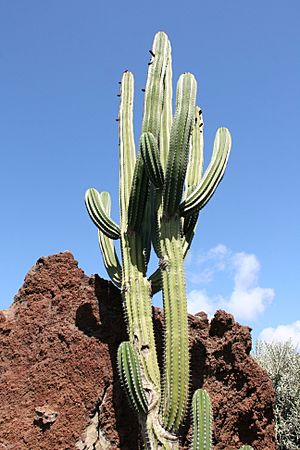Pachycereus pecten-aboriginum facts for kids
Quick facts for kids Pachycereus pecten-aboriginum |
|
|---|---|
 |
|
| Conservation status | |
| Scientific classification | |
| Genus: |
Pachycereus
|
| Species: |
pecten-aboriginum
|
| Synonyms | |
|
|
The Pachycereus pecten-aboriginum is a tall, column-shaped cactus plant. People often call it the hairbrush cactus or Indian comb cactus. It grows naturally in Mexico. This amazing plant can reach heights of up to 15 meters (about 50 feet)! Its trunk can be between 1.2 and 5 meters tall. The fruits of this cactus are big and look a bit like burrs. The scientific name, pecten-aboriginum, comes from Latin. It means "native combs," because people used the fruits as hair combs.
Contents
Where the Hairbrush Cactus Lives
The hairbrush cactus is special because it only grows in Mexico. You can find it across the western parts of the country, from Baja California all the way to Chiapas. It thrives in different desert areas like the Chihuahuan Desert and the Sonoran Desert. It also grows in the thorny forests of Sinaloa and the plains of southern Sonora.
Home Sweet Home: Cactus Habitats
This cactus likes to grow in many different places. You can spot it on hillsides, flat plains, in valleys, and even in dry riverbeds called arroyos. Its favorite homes include areas with thorny bushes, tropical forests that lose their leaves, and the scrublands of the Sonoran Desert. It's very common in the warm, subtropical scrub areas of southern Sonora, especially in the foothills and lower mountains.
What the Hairbrush Cactus Looks Like
The Pachycereus pecten-aboriginum is a tree-like cactus that can grow up to 15 meters tall. Its branches stand straight up or lean upwards, and they can be as wide as 25 centimeters (about 10 inches). Young stems are about 22 cm wide and have 10 or 11 ridges. Older stems are a bit narrower, around 17.5 cm wide, with 10 to 12 ridges. Along these ridges are small, raised spots called areoles. These areoles have stiff, sharp spines that are white to gray. On older stems, these spines might even be curved.
The flowers of this cactus are white and about 5 to 7.5 cm long. They open in the evening and close by midday. The part of the flower that holds the seeds, called the ovary, is covered in soft, brown hairs. The flowers bloom from January through March.
The fruit of the hairbrush cactus is covered in many long, golden-yellow spines that can be up to 6 cm long. The fruit ripens in June and July. When it's ready, it splits open. Inside, you'll find a thin layer of firm, red, juicy pulp and shiny black seeds. Each seed is about 0.5 cm long.
How the Cactus Reproduces
The hairbrush cactus is a diploid plant, which means it has two sets of chromosomes. How its flowers are pollinated can be different depending on where it grows. In a place called Tehuacán, bats that drink nectar help pollinate the flowers at night. But in the Sonoran desert, the flowers stay open longer during the day. This helps them attract both nighttime and daytime pollinators.
Cool Uses for the Hairbrush Cactus
People have found many ways to use the hairbrush cactus!
Food from the Cactus
The fruit of this cactus can be eaten fresh or cooked. You can also turn it into a sweet syrup, preserves, or jam. Some people have even made wine from it! The Mayo people, who are an indigenous group, used to make tortillas by grinding the seeds and mixing them with some corn meal. This special flour was used to make breakfast foods like pancakes.
Cactus as Medicine
The Mayo people also used this cactus as a natural medicine. They would put pieces of the cactus flesh on wounds to help stop bleeding. They also cooked the cactus flesh in salty water. This solution was then put on infected wounds three times a day, sometimes followed by a special powder called sulfathiazole. People also drank the juice as an herbal tonic and to help with a sore throat.
Making Hair Combs
One of the most interesting uses for the fruit was as a comb! Indigenous peoples would make hairbrushes from them. To do this, they would remove the spines from about two-thirds of the fruit. The remaining spines were then trimmed to about 1 cm long, making a natural comb.
See also
 In Spanish: Pachycereus pecten-aboriginum para niños
In Spanish: Pachycereus pecten-aboriginum para niños


